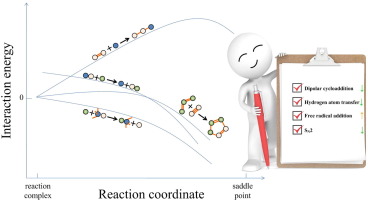Computational and Theoretical Chemistry ( IF 3.0 ) Pub Date : 2019-11-11 , DOI: 10.1016/j.comptc.2019.112640 Wanqiu Huang , Runxing Lin , Xiaotian Zhao , Qiuxia Li , Yugang Huang , Guodong Ye

|
An activation strain model was used to reveal the behavior of interaction, which was divided into four types as it proceeded from the reaction complex to the saddle point. For the 1,3-dipolar cycloaddition reaction, the interaction remained nearly zero at the first stage, but then decreased dramatically to become negative in the final stage. For the hydrogen atom transfer reaction, it started with a large positive value, which then fell to zero in the end. For Sn2 reaction, it decreased asymptotically from the beginning to the end. For the free radical addition reaction, meanwhile, it began on a zero point and climbed steadily up to a high positive value, but then decreased slightly at the saddle point. The use of an independent gradient model reveals a weak interaction containing both attractive and repulsive forces. These four types of behavior are the result of a compromise/balance between attraction and repulsion forces.
中文翻译:

弱相互作用如何从反应性络合物变为反应中的鞍点?
活化应变模型被用来揭示相互作用的行为,从反应复合体到鞍点,相互作用模型被分为四种类型。对于1,3-偶极环加成反应,相互作用在第一阶段几乎保持为零,但在最后阶段急剧下降为负。对于氢原子转移反应,它以一个大的正值开始,然后最终降为零。对于S n2反应,它从头到尾渐近减少。同时,对于自由基加成反应,它从零点开始并稳定地上升至高正值,但随后在鞍点处略微下降。独立梯度模型的使用揭示了既包含吸引力又包含排斥力的弱相互作用。这四种行为是吸引力和排斥力之间折衷/平衡的结果。











































 京公网安备 11010802027423号
京公网安备 11010802027423号